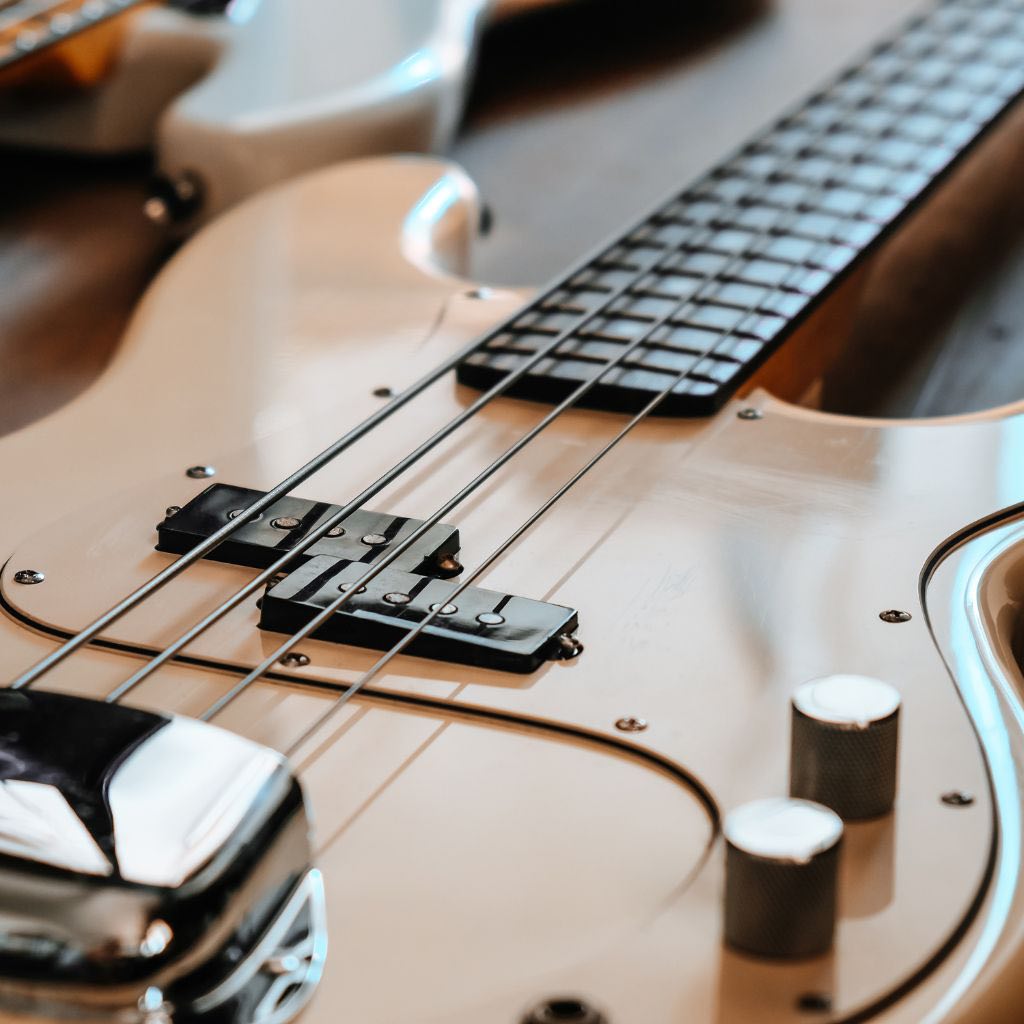Playing guitar is amazing, but keeping your instrument in perfect shape requires the right tools. A complete guitar tool kit contains essential items like screwdrivers, hex wrenches, string winders, and cleaning supplies that help maintain your guitar’s playability and tone.
I’ve spent countless hours researching and testing different guitar tools to find what really works. From basic maintenance to complete setups, having the right equipment makes all the difference in how your guitar sounds and feels.
Whether you’re a beginner learning basic care or an experienced player doing your own setups, I’ll walk you through everything you need to know about guitar tools. Let me share what I’ve learned about building the perfect toolkit for your musical journey.
What Is a Guitar Tool?
Guitar tools are special items made to help fix, adjust, and take care of guitars. I use these tools for guitar maintenance and guitar repair tasks that keep my instrument playing its best.
Primary Uses for Guitar Tools
Guitar tools help me do many important jobs on my guitar.
The main use is adjusting parts like the neck, bridge, and tuning pegs to make sure everything works right.
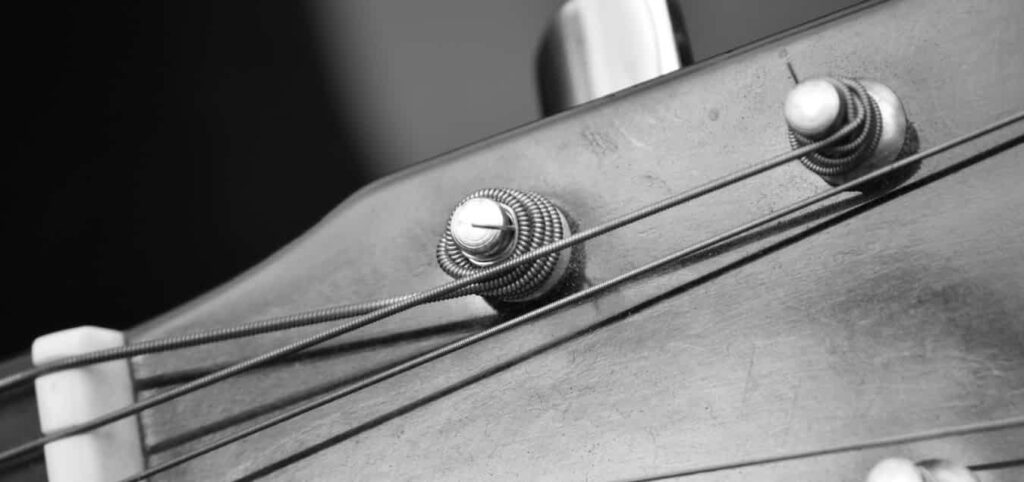
I also use these tools to change guitar strings safely. Many tools help me remove old strings and put on new ones without damaging my guitar.
Guitar maintenance is another big job for these tools. I can clean hard-to-reach spots, oil the fretboard, and check that all screws are tight.
Some tools help me fix problems when they happen. If my guitar buzzes or sounds off, I can use special tools to find and fix the issue.
Different Types of Guitar Tools
I can group guitar tools into a few main types.
String tools include string winders, cutters, and stretchers that help me change strings quickly.
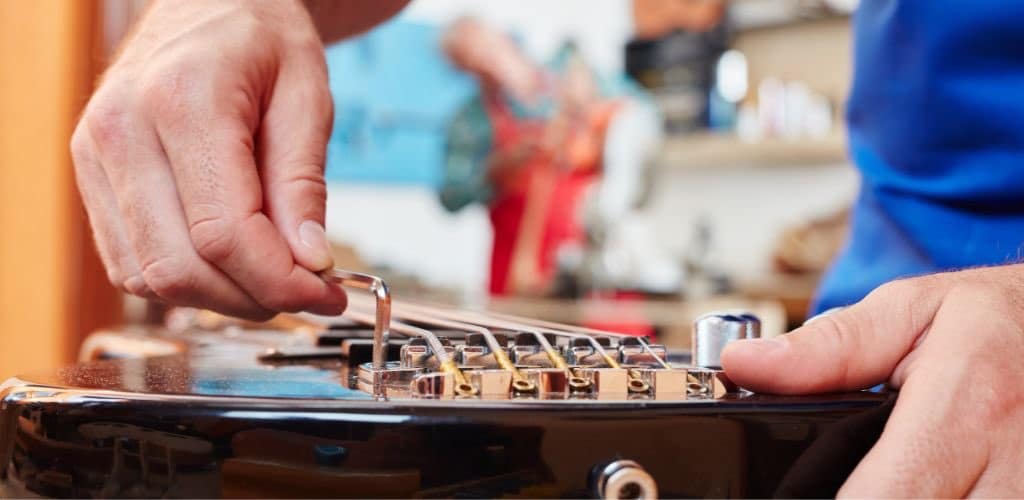
Adjustment tools are probably the most important ones I own. These include hex keys, screwdrivers, and nut files for making precise changes to my guitar’s setup.
Measurement tools help me get things just right. I use rulers, feeler gauges, and string action gauges to measure distances and heights on my guitar.
Cleaning supplies keep my guitar looking and sounding great. I use special cloths, polishes, and brushes made just for guitars.
Many companies sell tool kits that include several tools in one package. These kits are perfect for beginners who want to start doing their own guitar work.
Key Tools Every Guitarist Needs
I’ve found that three specific tools make the biggest difference when maintaining guitars. These tools handle the most common tasks like changing strings, adjusting necks, and tightening hardware.
String Cutter and Wire Cutter
I always keep a good string cutter in my toolkit because it makes string changes so much cleaner. Regular scissors just don’t cut guitar strings properly and can leave sharp, frayed ends that might scratch your guitar.
A quality wire cutter gives you precise cuts every time. I like cutters that have a flush-cutting design because they trim strings right at the tuning peg without leaving little metal spikes sticking out.
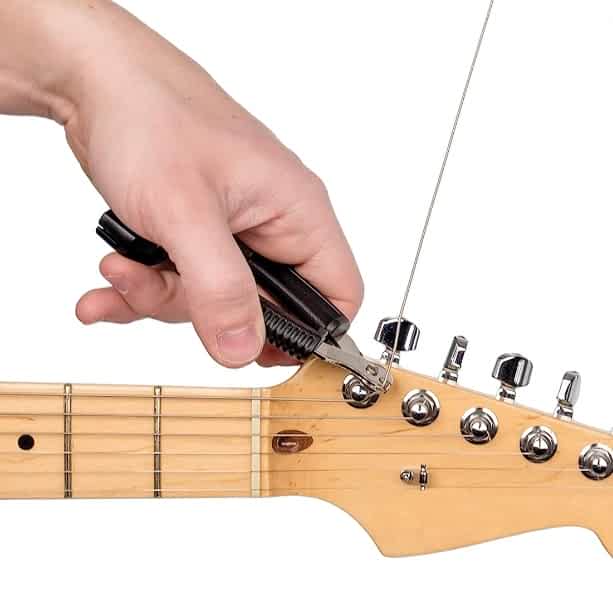
Key features I look for:
- Sharp, hardened steel blades
- Comfortable grip handles
- Flush-cutting design
- Compact size for easy storage
The best string cutters cost between $15-30 and last for years. I’ve tried cheap ones, but they get dull quickly and can actually damage your strings during installation.
String Cutter and Wire Cutter
My string winder saves me tons of time when changing strings. Instead of turning each tuning peg by hand dozens of times, I can wind new strings in seconds.
Most peg winders have a simple crank design that fits over your tuning pegs. I prefer the ones with a comfortable handle because string changes involve a lot of repetitive motion.
Essential features:
- Fits standard and vintage tuning pegs
- Smooth turning action
- Built-in bridge pin puller (for acoustic guitars)
- Durable plastic or metal construction
Some string winders come with extra tools attached. I’ve found the bridge pin puller feature especially helpful for acoustic guitar maintenance.
Electric string winders exist, but I think manual ones work just fine. They’re cheaper, more reliable, and give you better control over string tension.
D'Addario Guitar Pro-Winder

COMES WITH: peg winder with a built-in clipper, bridge pin puller and string stretcher
FEATURES: Good for All Types of Guitar
D'Addario Guitar Pro-Winder
- Ergonomically designed
- Compact, Easy to Carry
- An All-in-One Tool for Restringing
- None!
When you click ‘Check Price’, you’ll see there are loads of great places to buy this item. Our personal favorite is Sweetwater for the US, and Thomann and Gear4Music for the UK & Europe.
They are the largest music retailers, with excellent customer service, competitive prices, really fast shipping, and the longest guarantees.
The professional musician who wrote this article combined many things,
from the product build, manufacturer’s reputation through to feedback
from other users, to create our famous TedScore™.
Hex Keys and 4-in-1 Screwdriver
Hex keys are essential for adjusting truss rods and bridge hardware. Most guitars use 4mm or 5mm hex keys, but sizes vary by manufacturer.
I keep a complete set of metric hex keys from 1.5mm to 6mm. The truss rod adjustment is the most important use, but I also need them for bridge saddles and pickup rings.
A 4-in-1 screwdriver handles most other guitar hardware. These tools have four different screwdriver bits in one handle – usually two Phillips head sizes and two flathead sizes.
What I use mine for:
- Pickup height adjustments
- Strap button installation
- Bridge saddle adjustments
- Electronics cover plates
The best guitar screwdrivers have magnetic tips that hold screws securely. I’ve dropped way too many tiny screws inside guitar bodies, so this feature really matters.
Guitar Tool Kits and Setup Kits
Guitar tool kits bundle all the essential tools you need for basic maintenance and adjustments in one convenient package. These kits range from simple multi-tools to comprehensive sets with specialized instruments for professional setups.
What to Expect in a Guitar Tool Kit
Most guitar tool kits include a combination screwdriver with multiple heads for different screw types. You’ll typically find both Phillips and flathead bits in various sizes to handle bridge adjustments and tuning peg maintenance.
Hex keys are another standard inclusion. These come in metric and imperial sizes to adjust truss rods, bridge height, and pickup mounting rings.
A string winder speeds up string changes significantly. Many kits include a basic plastic version, though some feature built-in string cutters for added convenience.
Measuring tools like rulers or feeler gauges help you set proper string height and neck relief. Some kits include specialized guitar-specific measuring devices.
Additional items might include:
- String cutters or wire snips
- Nut files for slot adjustment
- Small pliers for hardware manipulation
- Polishing cloths
- Carrying case or pouch
Top-Rated Guitar Tool Kits
The Ernie Ball Musician’s Tool Kit stands out as a well-balanced option for intermediate to professional players. It offers excellent value with reliable construction and all the basics covered.
Fender Custom Shop guitar tools work particularly well if you own Fender instruments. Their kit includes a versatile 4-in-1 screwdriver, hex wrenches, and a string winder specifically designed for Fender hardware.

For budget-conscious players, the Senrob 26-piece kit provides impressive tool variety at a lower price point. It includes most essentials plus extras like multiple gauge options.
D’Addario and MusicNomad also produce quality guitar maintenance kits. These brands focus on professional-grade tools that last longer under regular use.
Ernie Ball Guitar Tool Kit

COMES WITH: All Necessary Tools You Need
FEATURES: A Quality Kit from Earnie Ball
- All Guitar Tools in One Storage
- Very Portable, Bring It Anywhere
- A Must Have for All Guitar Players
- None!
When you click ‘Check Price’, you’ll see there are loads of great places to buy this item. Our personal favorite is Sweetwater for the US, and Thomann and Gear4Music for the UK & Europe.
They are the largest music retailers, with excellent customer service, competitive prices, really fast shipping, and the longest guarantees.
The professional musician who wrote this article combined many things,
from the product build, manufacturer’s reputation through to feedback
from other users, to create our famous TedScore™.
How to Choose the Right Guitar Setup Kit
Consider your guitar types first. Some tools work better with specific brands or models, so compatibility matters more than you might think.
Skill level influences kit selection too. Beginners need basic adjustment tools, while advanced players benefit from precision measuring devices and specialized files.
Think about portability if you travel with your guitar. Compact kits with sturdy cases protect tools and fit easily in guitar bags.
Build quality varies significantly between brands. Metal components last longer than plastic ones, especially for frequently used items like string winders and hex keys.
Price doesn’t always indicate quality, but extremely cheap kits often include tools that bend or break quickly. I recommend investing in mid-range options for the best balance of cost and durability.
Essential Tools for Guitar Maintenance
Three specific tools make the difference between amateur tinkering and precise guitar maintenance: string action gauges that measure exact string height, feeler gauges for micro-adjustments, and multitools that handle multiple tasks efficiently.
String Action Gauge and Rulers
I use string action rulers daily because they measure the exact distance between strings and frets. This measurement tells me if my guitar plays smoothly or fights against my fingers.
Most action gauges show measurements in both inches and millimeters. I prefer the dual-scale options since different guitar specs use different units.
Typical action measurements:
- Low E string (6th): 2.0-2.5mm at 12th fret
- High E string (1st): 1.5-2.0mm at 12th fret
- Bass strings: Generally higher than treble strings
The string action gauge sits flat on the fret while measuring string height above it. I check action at both the 12th fret and sometimes the 17th fret for complete assessment.
Quality rulers have clear markings that don’t wear off with use. I’ve found that metal rulers with etched numbers last longer than printed plastic versions.
Feeler Gauges for Precision Adjustments
Feeler gauges measure tiny gaps that my eyes can’t see accurately. I use them mainly for checking neck relief and nut slot depth.
These thin metal strips come in sets with different thicknesses. I keep gauges from 0.002″ to 0.025″ in my toolkit for most guitar work.
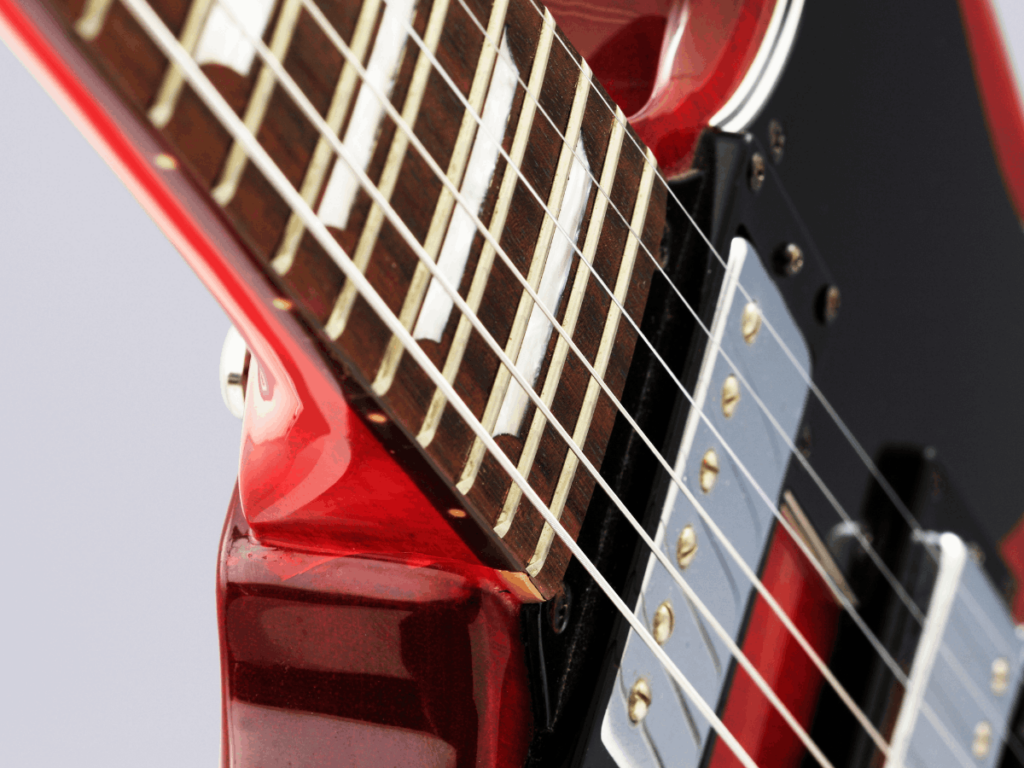
Common feeler gauge uses:
- Neck relief: 0.008″ to 0.012″ at 8th fret
- Nut slots: Match string diameter exactly
- Bridge saddle height: Fine-tune intonation points
I press the feeler gauge gently into the gap I’m measuring. The right thickness slides in with slight resistance but doesn’t force or bind.
Stainless steel feeler gauges resist rust and stay accurate longer. I avoid cheap sets because bent or damaged gauges give wrong measurements.
Multitools and Their Benefits
Guitar multitools pack several essential tools into one compact unit. I carry mine everywhere because it handles most quick adjustments and emergency repairs.
Most multitools include hex wrenches, screwdrivers, and string cutters. The Ibanez MTZ11 combines 11 tools in a lightweight package that fits in my gig bag easily.
Essential multitool features:
- Hex wrenches: 1.5mm, 2mm, 2.5mm, 3mm sizes
- Phillips and flathead screwdrivers: Multiple sizes
- String winder: Speeds up string changes
- String cutter: Clean cuts without fraying
I use my multitool for truss rod adjustments, saddle height changes, and pickup height tweaks. The compact design means I never leave it behind at home.
Quality multitools have tools that lock securely in place during use. Cheap versions wobble or fold unexpectedly, which can damage my guitar or hurt my fingers.
Cleaning and Care Accessories
Guitar cleaning accessories help protect your instrument from dirt, grime, and wear while maintaining its appearance and sound quality. The right cleaning cloths and products can extend your guitar’s lifespan and keep it looking new.
Microfiber Polish Cloths
I always keep a microfiber polish cloth in my guitar case because it’s the most important cleaning tool you can own. These cloths are specially designed to clean guitar finishes without scratching the surface.
Microfiber cloths work better than regular cotton cloths because they trap dust and oils instead of pushing them around. They’re safe for all guitar finishes, including glossy and matte surfaces.
I use my microfiber cloth before and after every playing session to wipe down the strings and body. This simple habit prevents buildup of oils from your hands and keeps your guitar looking great.
The best microfiber cloths are lint-free and washable. You can clean them with mild soap and water, then air dry for repeated use.
Most guitar maintenance kits include at least one microfiber cloth. I recommend having two – one for the body and one specifically for strings and fretboard cleaning.
Wonder Wipes and Guitar Cleaning Products
Wonder Wipes are pre-moistened cleaning cloths that make guitar maintenance incredibly easy. These individual wipes are specially formulated to clean strings, fretboards, and guitar bodies safely.
I love Wonder Wipes because they’re convenient and mess-free. Each wipe contains the right amount of cleaning solution, so you don’t have to worry about using too much product on your guitar.
These wipes work great for cleaning dirty strings and removing grime from fretboards. They’re designed to be non-abrasive and won’t damage your guitar’s finish.
Guitar-specific cleaning products like polishes and conditioners offer deeper cleaning than basic wipes. I use body polish to restore shine and protect against moisture and stains.
String conditioners help your strings last longer and feel smoother under your fingers. Fretboard cleaners and conditioners keep the wood healthy and prevent cracking.
GHS Fast Fret String Lubricant
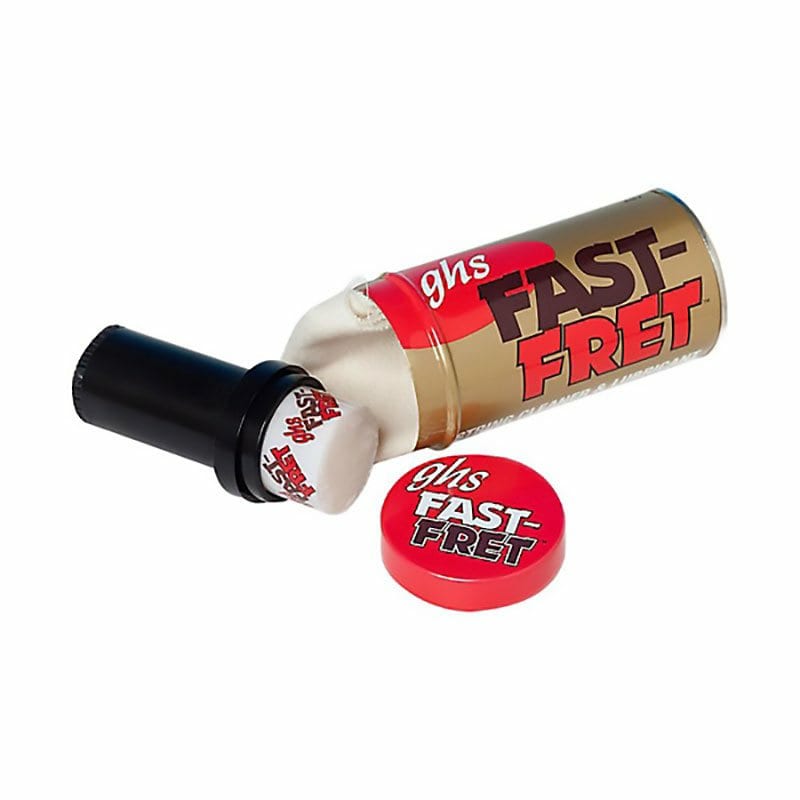
COMES WITH: Includes applicator and cleaning cloth
FEATURES: Silicone free
- Easy Application
- Removes accumulated dirt and grime
- Strings sound 'bright' and new
- None!
When you click ‘Check Price’, you’ll see there are loads of great places to buy this item. Our personal favorite is Sweetwater for the US, and Thomann and Gear4Music for the UK & Europe.
They are the largest music retailers, with excellent customer service, competitive prices, really fast shipping, and the longest guarantees.
The professional musician who wrote this article combined many things,
from the product build, manufacturer’s reputation through to feedback
from other users, to create our famous TedScore™.
Handy Extras and Maintenance Tips
Smart guitarists keep extra picks handy and organize their tools for quick access. Knowing when your guitar needs professional care can save you from costly mistakes.
Guitar Picks and Accessories
I always keep a small stash of guitar picks in my toolkit case. You’d be surprised how often you need one during maintenance work, especially when testing your guitar after adjustments.
Different pick thicknesses help me check how my setup feels across various playing styles. Thin picks reveal string buzz issues that thicker ones might hide.

Capos serve double duty in my maintenance routine. They hold strings in place when I’m working on the neck and help me check string height at different fret positions.
I also pack extra batteries for active pickups and a small LED keychain light. Dark practice rooms make precise adjustments nearly impossible without proper lighting.
Spare strap locks have saved me more than once. These tiny parts fail at the worst times, so having backups prevents emergency trips to the music store.
Guitar Picks by Gear4Music

COMES WITH: 24 piece in assorted Sizes
FEATURES: includes 24 quality shell guitar picks in assorted gauges
- Durable and Made with Quality Materials
- Comes in Assorted Colors & Gauge Sizes
- Very Afforable
- None!
When you click ‘Check Price’, you’ll see there are loads of great places to buy this item. Our personal favorite is Sweetwater for the US, and Thomann and Gear4Music for the UK & Europe.
They are the largest music retailers, with excellent customer service, competitive prices, really fast shipping, and the longest guarantees.
The professional musician who wrote this article combined many things,
from the product build, manufacturer’s reputation through to feedback
from other users, to create our famous TedScore™.
Quick-Access Tool Storage
My toolkit lives in a compact case that fits in any guitar bag. I organize tools by frequency of use, keeping string winders and allen keys in the most accessible spots.
Small magnetic trays work wonders for holding screws and springs during maintenance. Nothing kills productivity like hunting for a tiny bridge saddle screw that rolled under your amp.
I use clear plastic compartments to sort different screw sizes and spare parts. Being able to see everything at a glance speeds up any repair job significantly.
Tool rolls make excellent storage for longer items like rulers and screwdrivers. They protect delicate instruments while keeping everything organized and portable.
When to Visit a Pro Luthier
Luthier visits become necessary when you encounter fret work or major structural issues. I never attempt to level frets myself – the specialized tools and expertise required make this a professional job.
Neck resets, bridge repairs, and crack repairs demand professional attention. These complex procedures can permanently damage your instrument if done incorrectly.
If your guitar needs extensive setup work or you want to learn more about advanced maintenance techniques, spending time with a skilled luthier pays dividends. They can teach you proper techniques while handling the delicate work.
Trust your instincts about when to seek help. If a repair makes you nervous or requires tools you don’t own, professional service usually costs less than fixing mistakes.
Guitar players often wonder about the right tools for maintenance, repairs, and setups.
These questions cover essential kit contents, proper tool usage, trusted brands, digital alternatives, electric guitar setup needs, and DIY repair must-haves.
FAQ's
I recommend starting with the basic tools that handle most guitar maintenance tasks. Wire cutters, peg winders, and various screwdrivers form the foundation of any good kit.
Allen keys in different sizes are crucial for adjusting truss rods and bridge components. A string action gauge helps measure the distance between strings and frets accurately.
You’ll also want a digital multimeter for testing electrical components like pickups and potentiometers. Basic digital models with resistance measurement work perfectly fine for guitar diagnostics.
Don’t forget cleaning supplies like polish, fretboard oil, and microfiber cloths. These items keep your instrument looking and playing its best between major setups.
I always start by learning each tool’s specific purpose before touching my guitar. Reading the manual or watching tutorials prevents costly mistakes during repairs.
When adjusting the truss rod, I make quarter-turn increments and wait between adjustments. This prevents over-tightening which can damage the neck permanently.
For intonation work, I use a tuner and measure the 12th fret harmonic against the fretted note. Small bridge saddle adjustments fix most intonation problems effectively.
String action measurements require steady hands and good lighting. I take multiple readings across the fretboard to ensure consistent action heights.
I’ve found that StewMac offers professional-grade tools that last for years of regular use. Their kits include everything needed for complete guitar setups and repairs.
Fender and Gibson also make quality tool sets designed specifically for their instruments. These kits work well on other guitar brands too.
For budget-conscious players, I suggest looking at music store house brands or online retailers. Many offer decent starter kits at reasonable prices.
Individual tools from companies like Klein or Craftsman often outperform kit versions. I upgrade specific tools as my skills and needs grow.
Guitar tuner apps replace physical tuners and work surprisingly well for basic tuning needs. Most use your phone’s microphone to detect pitch accurately.
Chord calculator apps help identify complex fingerings and intervals during practice sessions. These tools support extended and altered jazz chords too.
I use metronome apps for timing practice and setup work that requires steady rhythm. Many include visual cues alongside audio clicks.
Some apps combine multiple functions like tuning, chord charts, and basic setup guides. These all-in-one solutions work great for beginners learning guitar maintenance.
I start electric setups with allen keys for truss rod and bridge adjustments. Most electric guitars use hex screws for these critical components.
A multimeter becomes essential for testing pickups, output jacks, and potentiometers on electric instruments. I check continuity and resistance values during troubleshooting.
Phillips and flathead screwdrivers handle pickup height adjustments and electronics work. Small precision drivers work better in tight spaces around pickups.
String action gauges help achieve consistent playability across all frets. I measure at multiple positions to ensure even string heights.
I consider a quality soldering iron essential for electronics repairs and modifications. Temperature-controlled models prevent damage to sensitive components.
A good set of nut files allows precise slot cutting for proper string spacing. These specialized tools create clean, accurate cuts in bone or plastic nuts.
Fret tools like pullers, hammers, and files handle major fretwork projects safely. I recommend starting with simpler tasks before attempting full refrets.
A radius gauge set helps match fingerboard curves during setup work. These tools ensure consistent action and playability across the entire neck.


